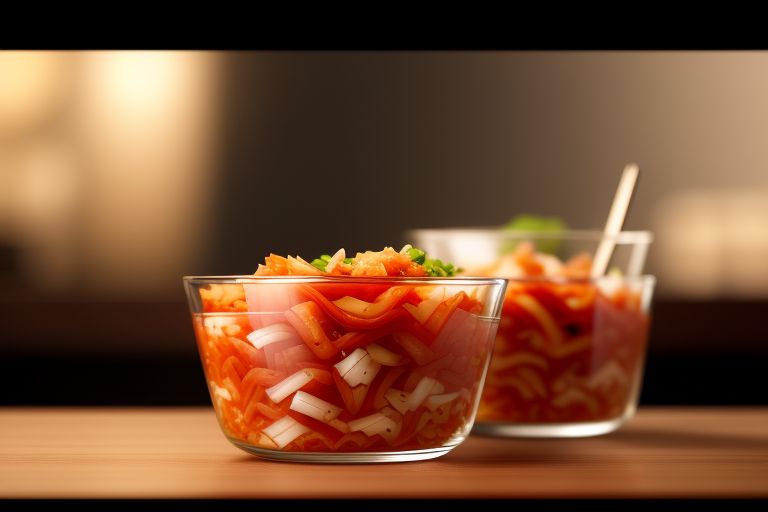Contents
Introduction
Kimchi is a traditional Korean dish that has its roots deeply embedded in the country’s culinary history. The origins of this iconic recipe can be traced back to ancient times, as early as the 7th century. Kimchi was initially created as a means of preserving vegetables, particularly cabbage, during the long and harsh winters. The fermentation process involved in making kimchi not only preserved the vegetables but also enhanced their flavors and nutritional value.
Over the centuries, the recipe evolved, and various regional variations emerged, each with its own unique blend of ingredients and seasonings. Today, kimchi has become a staple in Korean cuisine and is loved and enjoyed by people all around the world for its tangy, spicy, and umami flavors. Its rich cultural significance and health benefits have made kimchi an integral part of Korean identity and a symbol of Korean culinary heritage.
Additionally, the fermentation process of kimchi produces lactic acid bacteria, which are known for their probiotic properties. These beneficial bacteria help to improve digestion, boost the immune system, and support overall gut health. Furthermore, kimchi contains antioxidants and anti-inflammatory compounds that may contribute to reducing the risk of chronic diseases such as heart disease and cancer. With its unique combination of flavor, nutrition, and potential health benefits, kimchi has become a staple in many households and a popular addition to various cuisines around the world.
Kimchi Recipe
Kimchi is a traditional Korean dish that has gained popularity worldwide for its unique flavor and health benefits. The recipe for kimchi can vary slightly depending on the region and personal preferences, but the basic ingredients remain the same. The main ingredient in kimchi is cabbage, which is fermented with a combination of salt, garlic, ginger, and chili pepper flakes. Other common ingredients that can be added include radishes, carrots, and green onions.

Ingredients:
1 medium-sized napa cabbage
1/4 cup sea salt
2 tbsp. grated ginger
2 cloves
minced garlic
2 tbsp. fish sauce,
1 tbsp. sugar
1 tbsp. Korean red pepper flakes
2 green onions, chopped
1 carrot, julienned
Direction:
- Start by cutting the cabbage into quarters lengthwise and removing the core.
- Sprinkle salt on each cabbage leaf and let it sit for two hours. Soaking the cabbage in salt helps it get soft. Rinse the cabbage thoroughly and drain to remove any excess salt.
- Time to prepare the seasoning paste. In a large bowl, mix together the ginger, garlic, fish sauce, sugar, and red pepper flakes. Add in the green onions and carrot, then toss in the cabbage and mix well.
- Pack the mixture tightly into a clean jar, pressing down to remove air bubbles. Seal the jar and let it ferment at room temperature for 2-3 days before transferring it to the refrigerator. During the fermentation process, the flavors intensify, creating a unique and bold taste.
- Enjoy your homemade kimchi as a side dish or use it in various Korean recipes.
The process of making kimchi requires precision and attention to detail. The fermentation process not only enhances the flavor of the kimchi but also promotes the growth of beneficial bacteria, making it a probiotic-rich food that is good for gut health.
Print this recipe

Kimchi
Ingredients
- 1 medium-sized napa cabbage
- ¼ cup sea salt
- 2 tbsps. grated ginger
- 2 cloves minced garlic
- 2 tbsps. fish sauce,
- 1 tbsp. sugar
- 1 tbsp. Korean red pepper flakes
- 2 green onions, chopped
- 1 carrot, julienned
Instructions
- Start by cutting the cabbage into quarters lengthwise and removing the core. Sprinkle salt on each cabbage leaf and let it sit for two hours. Soaking the cabbage in salt helps it get soft. Rinse the cabbage thoroughly and drain to remove any excess salt.
- Time to prepare the seasoning paste. In a large bowl, mix together the ginger, garlic, fish sauce, sugar, and red pepper flakes. Add in the green onions and carrot, then toss in the cabbage and mix well.
- Pack the mixture tightly into a clean jar, pressing down to remove air bubbles. Seal the jar and let it ferment at room temperature for 2-3 days before transferring it to the refrigerator.
- During the fermentation process, the flavors intensify, creating a unique and bold taste. Enjoy your homemade kimchi as a side dish or use it in various Korean recipes.
In conclusion, the art of making kimchi involves carefully combining ingredients, allowing them to ferment, and creating a flavorful and nutritious dish. The process requires attention to detail and patience, as the flavors develop over time.

Whether enjoyed as a side dish, added to soups or stews, or used as a topping for rice bowls, kimchi offers a unique taste experience that is beloved by many. Its health benefits, including probiotic properties and a rich nutrient profile, make it a popular choice for those seeking a balanced and flavorful addition to their diet.
So roll up your sleeves, gather your ingredients, and let the fermentation magic begin! With a bit of patience and a dash of creativity, your kitchen will soon be filled with the vibrant aromas of homemade kimchi, ready to elevate any meal to a culinary masterpiece. Happy fermenting!
